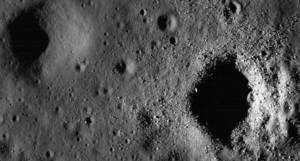China’s Chang’E-5 lunar lander made the first ever on-site measurement of water in lunar soil in 2020, but questions remained about where the water came from.
In a new paper published in the journal Nature Communications, researchers analyzing the samples on Earth have an answer as to where the water came from: The Moon.
It’s not as obvious an answer as it seems.
Water and hydroxyl — the latter consisting of a single hydrogen atom paired with an oxygen atom, instead of the two hydrogen to one oxygen of water — had been found in samples of lunar regolith taken by the Apollo program. Chang’E-5 also detected hydroxyl in its lunar rock and soil samples.
Hydroxyl often results from water chemically interacting with other material, but can also be formed by chemical reactions, and some theories hold that the hydroxyl resulted from hydrogen atoms carried by the solar wind interacting with the lunar soil. Chang’E-5 took its samples during low points in solar wind activity to help minimize the impact of that source of hydrogen on its measurements.
Read more: Independent
Ask me anything
Explore related questions





